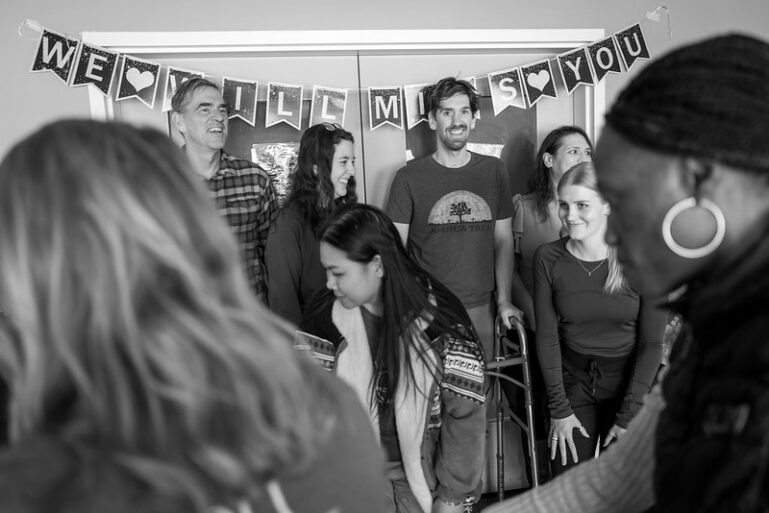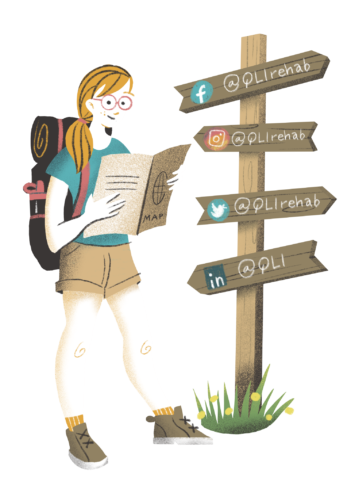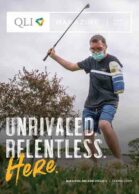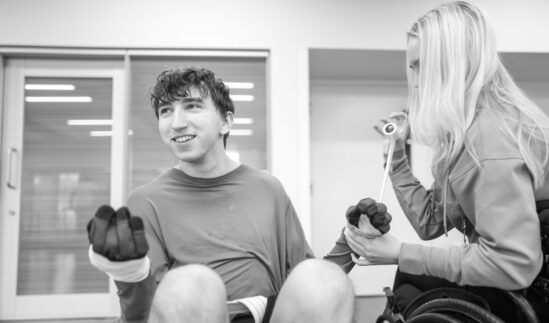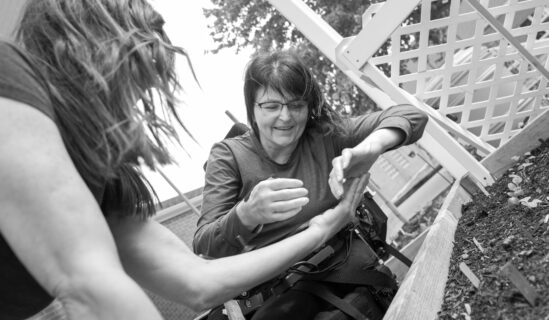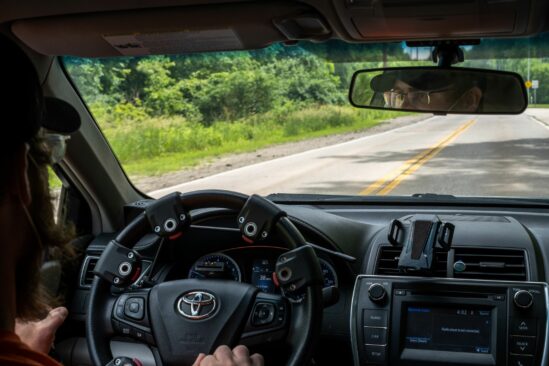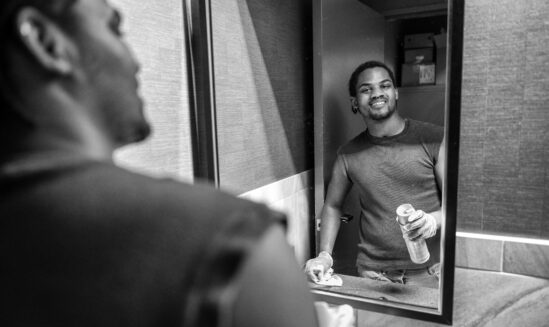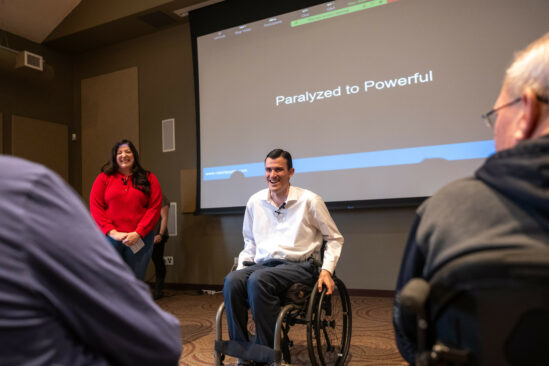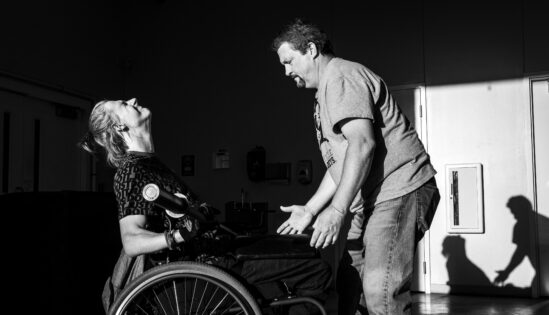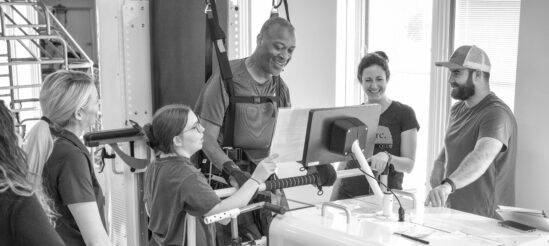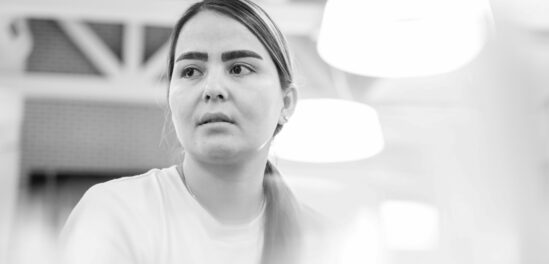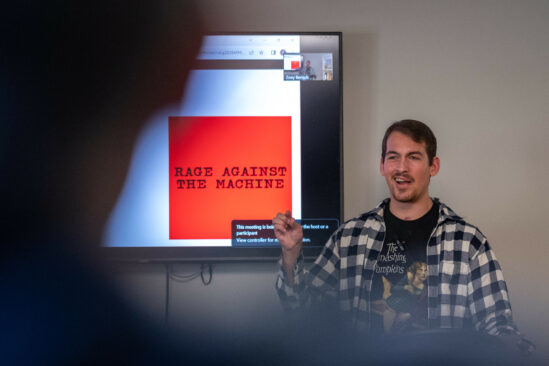He’s been practicing for weeks on the methodology in the Adaptive Sports Lab–the exact order to put his helmet and harness on, to prepare for the transfer up and out of his wheelchair, to rock climb with a sense of freedom he hasn’t caught in a very long time. But every climber needs someone to belay them, doling out the ropes and being a support, providing a safe measure for the group. Today it isn’t just anybody belaying Casey Evanoff—it’s his fiancé Dor and his father Mike. They’ve learned the ropes too, sending him up along the wall, supporting and sharing these moments with him, knowing that he is so close to discharging from inpatient rehabilitation at QLI.
sense of freedom he hasn’t caught in a very long time. But every climber needs someone to belay them, doling out the ropes and being a support, providing a safe measure for the group. Today it isn’t just anybody belaying Casey Evanoff—it’s his fiancé Dor and his father Mike. They’ve learned the ropes too, sending him up along the wall, supporting and sharing these moments with him, knowing that he is so close to discharging from inpatient rehabilitation at QLI.
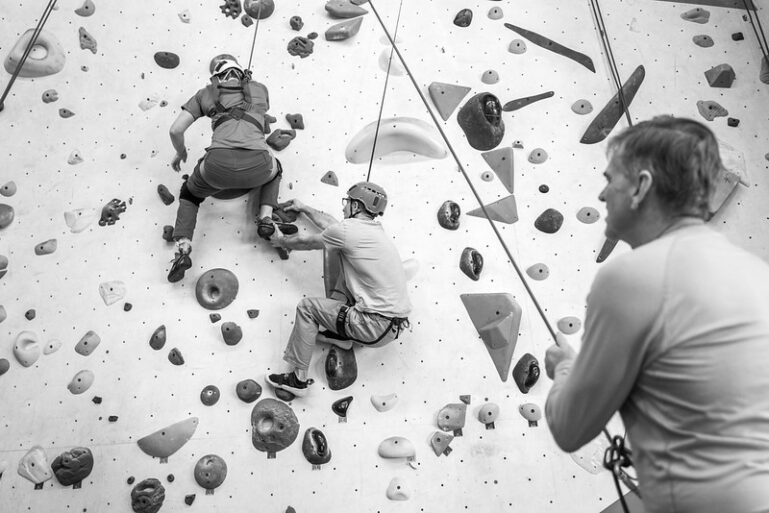
__
In the pictures that cover the walls of his room at QLI, Casey and Dor are out in the wide open. Nestled in a valley in Western Colorado, they’re standing perched on the in-progress roof of their tiny home. To say it’s a pet project would be an understatement. For Dor and Casey, their independence in all things is of absolute importance. She’s a part-time architect, he’s an app developer. Their lives are filled with nature, hiking, and just about everything one has on their bucket list was what their average days were like. They cherish the outdoors and the detachment from the greater world. Their free time, aside from working on the house, is spent rock climbing, while Casey pursues his passion of paragliding.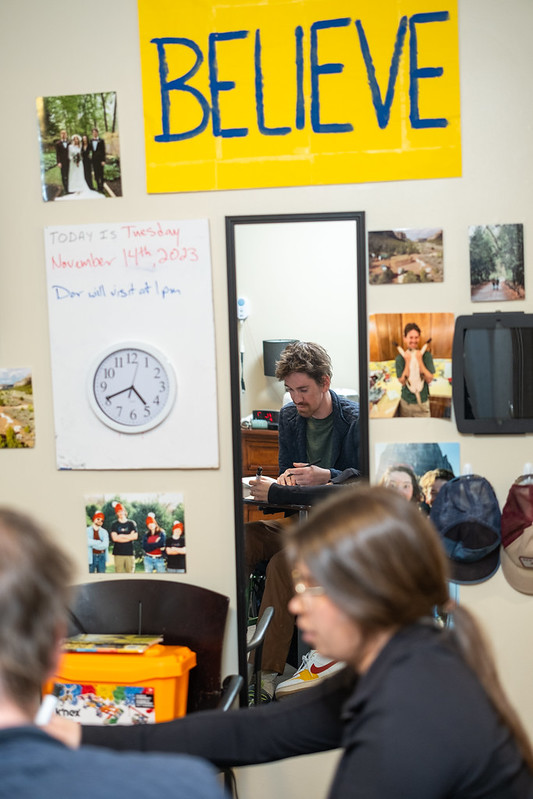 The markers live in the distant valley which, quite literally, line the walls of his room—life lived in the great outdoors or surrounded by close friends and family.
The markers live in the distant valley which, quite literally, line the walls of his room—life lived in the great outdoors or surrounded by close friends and family.
Ideally, time could move this fast constantly—from one moment to the next, a session today to one tomorrow. It would mean getting home sooner and faster, while at the same time moving closer to the past—the Casey of before the injury.
__
His eyes are set and focused on the tablet—though there could be the potential for distraction in the busy afternoon environment of the Colladay Center lobby, Casey doesn’t waver. Chin resting on hand with a slightly puzzled expression on his face, he taps the volume icon.
“SALAD,” the voice on the tablet intones in a cross between a mid-Atlantic and British accent. A Tristan chord sounds out silently from Casey’s mind—recognition, or at least a hint of it, is there. But not enough. Again, his finger hits the icon, and “SALAD” is spoken once more. The eyes move to the row of five letters jumbled in a mix at the bottom of the screen.
Casey makes his selection. “S – A – A” he begins, but then pauses. No, his face reads, something isn’t right. He taps the screen three times and the letters all reset to the bottom row. “S – A – A – D – L.” The final two letters are tapped and then swapped for “L – D.” Casey sighs, a ripple of frustration with himself evident, though it quickly abates.
He looks to his left at speech pathologist Zoey Bertsch with a half-shrug, lost in the world but wanting the right word to come about. Zoey brings out a whiteboard, writing down the letters as they appear in the jumbled sequence. She underlines the “S,” mimicking the “sss” sound the letter makes, and prompts Casey to do the same. They move on to “ah” for “A,” “el” for “L,” on through the rest of the letters.
Casey looks back to the tablet. It clicks. “S – A – L – A – D” he selects—assembled in the full correct order. There is a beat—Casey sounds out the word again, earning a “nice job” from Zoey.
With another prompt, he pulls up the Google Maps app on his phone. “Where is it that you live?” The question is asked, the eyes searching, yet no answer is being made. Cued to continue searching on the phone, Casey cycles through a map of the United States until he reaches Colorado. There, he zooms in on the western side of the state, until a space on the screen reads “Grand Junction.” He nods at the wide expanse of the countryside outside the city, quietly saying “Yep.”
__
It was and wasn’t a pandemic hobby that grew into something. “We were rock climbing one day,” remembers Dor, “and off in the distance we saw paragliders. Casey looked at me and said ‘I want to do that.’” Over the next three years, he started paragliding, and it quickly became one of his favorite activities.
“It’s a cardinal rule,” says Dor. “You never go paragliding alone.” In early March 2023, Casey went with some friends to the desolate landscape of Otto’s Ridge Paragliding. It was the early morning, and a friend saw him through the launch.
No one saw the accident, but dozens rushed in to help once the word was put out. Something caught the tip of the wing and violently pulled the glider, causing Casey to crash into the side of a cliff, where he fell twenty feet.
Casey was airlifted to St. Mary’s Medical Center in Grand Junction, CO, where he was shortly joined by Dor, other friends, and his parents Mike and Sherri. In the midst of it all, Casey could not pull memories, as he was in the grip of post-traumatic amnesia (PTA). The months ahead were swings of both high and low emotions. Early on, the family wasn’t sure if Casey would be able to breathe again on his own without a ventilator, but a few days after being informed of the possibility, he was able to do it. Things did not move quickly, but slow, gradual improvements marked every step of the way. After a few weeks at St. Mary’s, Casey went to the PAM Health Center for another couple of weeks, finally arriving at Craig Hospital in Denver.
As Casey came out of the PTA, he was shocked at the time that had passed. Even as he grew aware of 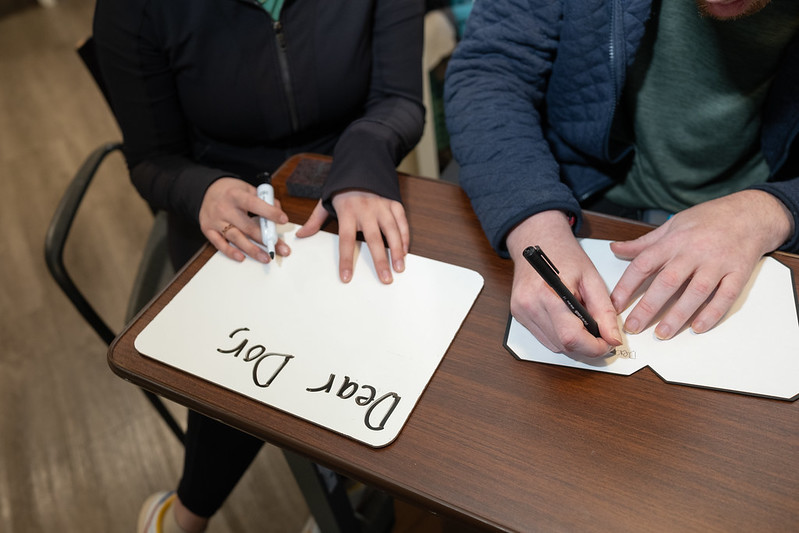 the physical and cognitive deficits brought on by his traumatic brain injury, he was set on getting back home as quickly as possible. There were so many things to do—continue building his house, getting back to work, doing rock climbing again. All these and more seemed right around the corner. But the reality was indeed time—there would still be a long but navigable road ahead.
the physical and cognitive deficits brought on by his traumatic brain injury, he was set on getting back home as quickly as possible. There were so many things to do—continue building his house, getting back to work, doing rock climbing again. All these and more seemed right around the corner. But the reality was indeed time—there would still be a long but navigable road ahead.
__
Casey’s goal was to return to all aspects of his day-to-day life—the most important of which was to continue to build his life with Dor. A key component of their remote and independent lives was in the structure they created for themselves—what their work schedules would look like, the construction punch list for their home, and the outdoor activities they wanted to do.
In his work with Zoey, Casey also moved through functional tasks in a meaningful way—reading and interpreting things such as texts and messages from loved ones, or articles about climbing and paragliding. Casey was encouraged to initiate and engage in leisure activities (such as hosting games at the house for team members and clients), with guidance on sequencing through the steps of each activity. Equally important through his work with Zoey and interactions with other clients and team members was growing comfortable and confident in his ability to advocate for himself, which is inherently difficult because of his aphasia (a language disorder which may result from brain injuries).
Apps such as Wordboard, which provides a phrase keyboard for the user, become immensely helpful in a multimodal capacity (such as hearing words from a text in addition to reading them). All of these were tools working towards the aim of stimulating and growing his cognition, language capabilities, and confidence. In addition to this was Day One, a journaling app that allows him to save information about individuals whom he interacts with daily, exercises and projects he’s been working with clinicians, as well as things such as his daily juice orders at the Hub Café in the Lied Life Center. These tools work towards the aim of stimulating and growing his cognition, sequencing, language capabilities, and confidence
as things such as his daily juice orders at the Hub Café in the Lied Life Center. These tools work towards the aim of stimulating and growing his cognition, sequencing, language capabilities, and confidence
Casey had immense support from family and friends. But to realize his potential, his clinical and residential teams were essential. An adventurous spirit has never been something Casey has lacked, and in a respect, his mind can be so future-driven that it is difficult to take into account the more micro-level accomplishments, which may seem inferior to the macro-level ones but equally important.
“These are opportunities to redirect Casey and encourage him,” says physical therapist Dani Gruber. “When we started working on transferring from the floor back to his wheelchair, it was key for Casey to not only understand the benefits of handling such a technique but also gain pride at what his family and friends will think when they stop by to shadow his sessions.” For those who make up his support, it’s easy to see progress every occasion they spend time with Casey—the contextualization from the outside looking in is much different the other way around.
Upon arriving at QLI in September 2023, Casey’s team immediately noticed these qualities of his personality. “In Casey,” says house coordinator Abi Fallah, “I saw two parts of him—the adventurous side, and the part that was truly grounded and driven.” Throughout the recovery process, Casey was fortunate to have the immense support of his family and friends. Yet, for him to fully realize his potential, trust had to be fostered with those at QLI—in the house team helping him in establishing his daily routines, and in the clinicians as his program was developed.
__
It was progress over time, remembers Coordinator of Adaptive Sports Ed Armstrong. “At first, we were working from the wheelchair, utilizing handholds at the base of the climbing wall, as well as getting some practice with tying rope.
Eventually, Casey stood supported from his chair to get a feel for how it would be at the gym. One foot down on the lower hold, another reaching higher for the other. With the support behind him, he grasps for the upper holds. In those moments, he’s not in the Lied Life Center, but back home in Colorado scaling immense cliff faces.
Casey, Ed, Dor, and Casey’s father Mike go regularly to Approach Climbing Gym. “The first time we went 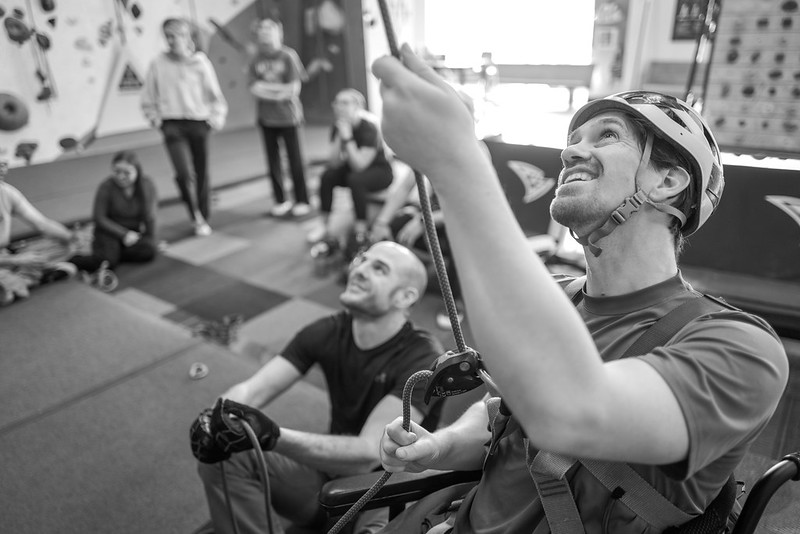 out there,” notes Ed, “Casey climbed about ten feet with significant support. The amount of assistance that Casey has needed has diminished considerably.” Now, Casey can make it to the top on his own. Just a few months before, lacking the strength to stand for an extended period, he utilized the tall peg board beside the rocking climbing fixture in the Adaptive Sports Lab.
out there,” notes Ed, “Casey climbed about ten feet with significant support. The amount of assistance that Casey has needed has diminished considerably.” Now, Casey can make it to the top on his own. Just a few months before, lacking the strength to stand for an extended period, he utilized the tall peg board beside the rocking climbing fixture in the Adaptive Sports Lab.
He’s relearned the process of belaying them. Sitting in his wheelchair at the bottom, he pays out the rope for Dor and Mike as they make their climbs. Casey, supporting them as they have supported him so greatly for nearly one year since the accident. Now, in February 2024, as he makes his trips to the climbing gym, there are so many more individuals around—QLI clients who themselves have become interested in trying the sport as a therapeutic method.
For Casey, pursuing adventure is one of the supreme thrills in life. “It’s a way for Casey to learn more about himself and different ways to exist in the world.”
And that pursuit is not lost in the slightest. “I can put in the work here at QLI and better myself,” reflects Casey, knowing that many of those core components of his life never went away. He’s already doing many of them again. They await his return.
